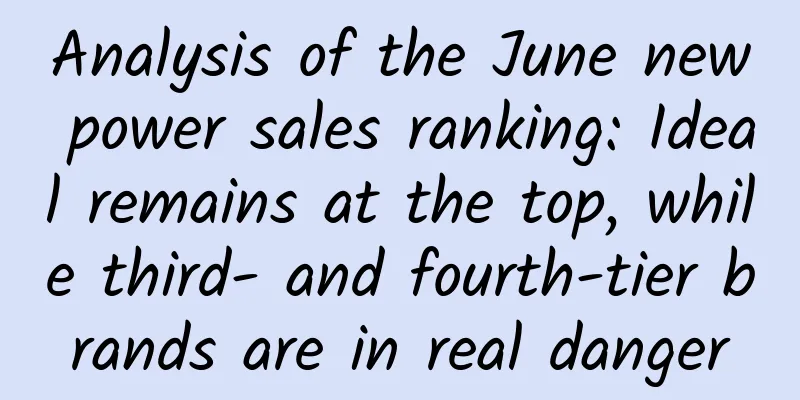Analysis of the June new power sales ranking: Ideal remains at the top, while third- and fourth-tier brands are in real danger

|
Delivery scale has become an important indicator for measuring the operating status of a new energy brand, and even small-scale new car manufacturers are no exception. In the first few days of July, domestic new car manufacturers released their June sales data. From these sales data, it can be seen that the next stage of competition among new car manufacturers will turn into a "scale competition." According to sales volume, the sales of new forces in June can be clearly divided into four levels. The first tier is Ideal and Wenjie. Among them, Ideal Auto sold 47,774 vehicles per month, and Wenjie sold 43,146 vehicles per month. They are the only two new power brands with monthly sales of more than 40,000 vehicles, and are well-deserved leaders of new power. If they can maintain an average monthly sales volume of 40,000 vehicles, Ideal and Wenjie may be able to achieve annual sales of 500,000 vehicles by 2024. What does this mean? Mercedes-Benz, Audi and BMW, the three major luxury brands, only sell about 600,000 vehicles in China each year. Ideal World has only been in business for a short time, but its scale is already comparable to the three traditional giants. More importantly, both Ideal and WJE are still focused on the high-end market. The price of Ideal's main models is more than 300,000 yuan, and the WJE M9 with a price of more than 500,000 yuan accounts for almost half of WJE's sales. Unless these two brands make fatal mistakes, it will be difficult for new forces to challenge them in 2024. The second-tier brands include NIO, Leapmotor, Zeekr, and Aion, with monthly sales of more than 20,000 vehicles. Among them, Aion's monthly sales were 35,027 vehicles, a year-on-year decrease of 22.18% and a month-on-month decrease of 12.59%; NIO's monthly sales were 21,209 vehicles, a year-on-year increase of 98.09%; Leapmotor's monthly sales were 20,116 vehicles, a year-on-year increase of 52.3%; Zeekr's monthly sales were 20,106 vehicles, a year-on-year increase of 89%. Why is Aion, with monthly sales of more than 30,000, included in the second tier? Because Aion is the only new force that has seen a sharp decline in both year-on-year and month-on-month sales in June. In addition, most of Aion's sales are contributed by the B-end market. It has no distinct brand characteristics and no technological advantages, and its prospects are not clear. NIO is gradually showing signs of "going ashore", and if it can maintain this momentum it will be a victory; Leapmotor has strong partners and great potential for overseas business; and Zeekr, backed by Geely Auto, also has good prospects. The third tier of new energy brands include DeepBlue, Xiaopeng, Nezha, Xiaomi, and Arcfox, with monthly sales ranging from 10,000 to 20,000. Among them, DeepBlue Auto's monthly sales were 16,659 units, Xpeng's monthly sales were 10,668 units, Nezha's monthly sales were 10,206 units, and Xiaomi's monthly sales were 10,000 units. Compared with the first and second tier brands, these brands are actually not very stable, because monthly sales of over 10,000 are not a remarkable achievement, especially in the fiercely competitive year of 2024. The fourth tier of new energy brands mainly consists of some second-generation innovative cars, with monthly sales of less than 10,000 vehicles. The gap with the first three tiers is quite obvious, and it is difficult to see signs of a turnaround in the short term. Judging from the overall sales in June, the gap between different levels of new car-making forces has become quite obvious, and the lineup of each level is relatively fixed. It is unlikely that a new force brand will emerge in the short term that can break through the current pattern. In addition, among the new force brands, the strong are getting stronger. Although the prices of Wenjie and Ideal are high, their sales continue to grow, showing a trend of "increasing both quantity and price". Among the third-tier new force brands with "monthly sales of over 10,000", many are struggling to maintain their operations, and some brands are even experiencing negative growth, and the possibility of them exiting the mainstream market is relatively high. Sales volume is becoming the "lifeline" for new energy brands. If they cannot even achieve monthly sales of over 10,000, it will be difficult for them to gain a foothold in the highly competitive Chinese new energy market in the future. Is it a high requirement to sell over 10,000 vehicles per month? No, for the main models of traditional manufacturers such as Geely, Changan, Great Wall, Toyota, and Volkswagen, monthly sales of over 10,000 vehicles are just a passing line. Friends who play games all know the concept of "newbie protection period". In fact, new power brands have also had similar preferential treatment in the past few years. When observing these brands, the industry often pays more attention to their growth rate and development speed, and scale is not necessarily important. But in 2024, it is time for them to show results. Why is delivery scale so important to an automobile manufacturer? First, the delivery scale determines the "visibility" of a car in traffic. Consumers often follow the trend when buying cars. The Han and Ideal L series running all over the streets are the best interpretation of the brand's influence, which is more useful than any advertisement. Once the delivery scale reaches a certain level, it is easy to form a good reputation. Secondly, the automotive industry is a low-profit industry. The scale of delivery is based on the scale of purchase. The higher the sales volume, the stronger the bargaining power of the manufacturer. Even if the entire set of Qin L technology was given to Xiaomi, Lei Jun would not dare to set the starting price at 99,800 yuan, because the scale is too small and the purchase cost is high. In addition, as sales volume increases, the initial R&D costs of automobile manufacturers will be quickly diluted, and the speed of technology introduction into vehicles will be greatly accelerated, which will not only help improve the profit level of manufacturers, but also facilitate the rapid updating of technology. Generally speaking, manufacturers spend huge amounts of money on independent research and development, and they have to recover the costs within a certain period of time. The larger the delivery scale, the faster the costs are recovered, and the easier it is to invest in the next round of research and development. Will the core equipment like the super hybrid DM-i be able to play its potential in the hands of new forces with monthly sales of 10,000 vehicles? Obviously not. Is Toyota's core technology in the field of fuel vehicles really much higher than that of Hyundai? Not really, but Toyota's terrifying annual sales of tens of millions are enough to allow its technology to quickly sink and occupy the minds of users. The further the automotive industry develops, the smaller the technological gap between major manufacturers will be. Ultimately, success will come from scale. This is an objective law, and this applies to both fuel vehicles and new energy vehicles. As of now, the delivery scale of Wenjie and Ideal has far surpassed that of traditional second-tier luxury brands such as Volvo, Lexus, Cadillac, and Land Rover, and has basically established their mainstream position in the market. Unless some irreversible major crisis breaks out, Wenjie and Ideal will inevitably book two tickets to become "mainstream brands in the new energy market." But for other brands, this ticket is still out of reach. To break through the current sales volume, those second- and third-tier new power brands must continue to research and develop and strengthen their core selling points in order to attract more users. Again, there is not much time left for second- and third-tier new brands, because the entire market's attention is focused on the leading manufacturers, and in the end only three or five brands may survive. So, among the many emerging brands, which ones do you think will never be able to board the big ship of China's new energy vehicles? As a winner of Toutiao's Qingyun Plan and Baijiahao's Bai+ Plan, the 2019 Baidu Digital Author of the Year, the Baijiahao's Most Popular Author in the Technology Field, the 2019 Sogou Technology and Culture Author, and the 2021 Baijiahao Quarterly Influential Creator, he has won many awards, including the 2013 Sohu Best Industry Media Person, the 2015 China New Media Entrepreneurship Competition Beijing Third Place, the 2015 Guangmang Experience Award, the 2015 China New Media Entrepreneurship Competition Finals Third Place, and the 2018 Baidu Dynamic Annual Powerful Celebrity. |
<<: What is different about the Honor 7, other than just fingerprint recognition and all-metal?
>>: iPhone 6s internal chip revealed: there is still a 16GB version
Recommend
YunOS adds power to the A380 with outstanding highlights
The emergence and popularization of smartphones h...
How to edit Tik Tok movies into short videos?
Recently, with the rapid development of short vid...
How to promote products on Douyin? How to promote products through TikTok?
If you want to better promote products on the Dou...
The entire process of traffic monetization, 7 key links!
Paul Gram said: The essence of entrepreneurship i...
How to choose bidding software for bidding promotion?
When we do bidding promotion, we will come into c...
Four major marketing details of APP make your APP unique
Abstract : 1. Focus on user experience. Today'...
For the first time in the world, a three-dimensional simulation of a "supernova" has finally been achieved, which is 100 times brighter than a supernova!
[Mobile software: Bo Ke Yuan] For most of the 20t...
What is the reason for accelerating the construction of a unified national market? What kind of national unified market should be built?
On April 10, the "Opinions of the CPC Centra...
Share the Douyin Book List Project, a way to play without being on camera
The day before yesterday, I shared an article: &q...
World No Tobacco Day丨What will happen if you smoke for more than 15 years?
Today is the 35th World No Tobacco Day. The theme...
Sharing 5 practical methods for promoting WeChat mini programs. How to attract traffic to mini programs?
A good name will inevitably bring high traffic. Z...
This is the only thing that makes you happier than receiving a year-end bonus.
Every time when New Year's Day or Spring Fest...
Neither the excellence of a single product nor Xiaomi’s experience can save Vancl
At the Vancl press conference on the 28th, Chen N...
How much does WeChat Mini Program certification cost? Is there any charge for WeChat Mini Program authentication?
Before businesses start developing WeChat mini-pr...
Huizhou SEO training: scientific website promotion and optimization strategy
Now network optimization technology is more criti...









